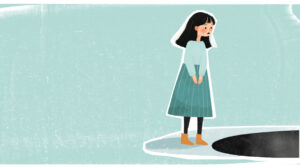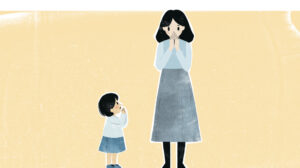Blended Families
| June 24, 2020Blended families never really blend — you stick them together

The shadchan called Erev Succos. “I have someone promising for you.” I listened to the information. I’d been alone for a year and a half since the divorce. This sounded right.
“Will you fly in to the States to meet him, and if it goes well, you can meet his whole family? Then he could fly to see you in Israel.” That sounded overwhelming, but the practicality spoke to me. And the adventure. Setting places for my children to stay wasn’t easy or comfortable. I didn’t tell them why I was going.
It was dreamy and fantastic: I could see building a home together. But could our kids? He flew to Israel alone a few weeks later to meet my children. Went well. Next. Married. Next.
The first time our kids met was shortly afterward, just before Pesach. My children and I got off the flight to New York and entered our future home, stepping into a birthday party arranged for my youngest daughter Shaindy. New aunts, uncles and cousins also came — it was a big crowd. The room was decorated, the cake and special chair set up.
Shaindy sat down, and that’s when we saw the candles on the cake, something we held should not be done. Inner gasp. Shaindy looked up at me, then back at the lit candles, wondering what to do — they were starting to burn down toward the frosting, everyone transfixed. Don’t get lost in the details, I told myself. I leaned forward, smiling. “You can blow them out,” I said.
The children eyed each other cautiously, eagerly that first Yom Tov. There were card games, fun outings, spontaneous walks, and endless seudos. There were questions: “We’re going to start keeping two days?” “How do you handle two-day Yom Tovs? I can’t wait for a shower!” the Israeli set asked the chutz l’Aretz set.
My husband and I had met with a prominent rav we both respected before we got married. “I ask you to do two things,” he told us. “Decide together what the children are going to call you. And choose your rav together.” My children were asked to call my husband Ta, but half now call him Tatty. And I’m called Mommy, except by one child for whom it’s too close for comfort, so I’m Mom. The point is consistency and respect.
And having a rav is critical. Yes, we call our rav with typical sh’eilos, but it’s more than that. There were new minhagim. You use thick but weak Shabbos soap and I used thinned-down good stuff? I needed objective guidance. My daughter wants to stick with the old minhagim? Okay, she can, but it needs to be across the board. We have who to turn to.
In the beginning, small things threw me off-kilter. I took a coffee mug from the cupboard. “Um, Mommy, that’s Shloimy’s mug.” Okay, I put it back and took another one. “No, that one is Mimi’s.” Okaay…
I kept pulling out mugs. Everything belonged to someone and none of them were us! I wanted to cry, stomp my feet, and go home. I felt unwanted and unwelcome because we didn’t have mugs.
It was a defining moment: I signed up for this. And I’m the adult here. So I bought new mugs. Plenty of ’em. Purple mugs, Starbucks mugs, Famous City mugs, and mugs with Hebrew writing, #1 Ima.
Here’s the lowdown: Blended kids don’t actually blend. You stick them together and hope for the best. You so badly want them to get along, to see the good in each other. I’m fortunate because my girls are the ages of my husband’s boys, and my boys are the ages of his girls. I’ve heard of difficult situations — blended families that have girls the same age, in one case with the same name. Really tough. Having new siblings already brings about confusion about identity; when they’re the same gender and same age (let alone have the same name!) there can be uncertainty and competition.
Language says a lot. My husband introduced my son to his rav: “Good Shabbos, this is my new son Yossi.” I loved that! New son, not stepson. Brilliant move.
Still, my new daughter didn’t always want to cross the line into step and new or any of it. When I took my new daughter to a sheitel fitting, I knew to keep my mouth shut so the sheitelmacher shouldn’t discern my accent, different from my new daughter’s.
Recipe for blended bliss: patience, love, and blindness. I couldn’t truly be a mother to my husband’s children because my role would not include discipline. No boundaries coming from me. My ratio of postivity to negativity is 100–0.
When I catch a glimpse of a new kid, my new kid doing something way off standard — I didn’t see it. I’m blind to their faults and imperfections. I speak to them with love and see them as perfect-as-they-are. The imperfect love of a new mother becomes perfect for them.
We met with a fantastic marriage therapist before we blended. She handed each of us a paper and pen. “Draw circles of the relationships in your lives.” We drew our children first, of course, then our parents, then our siblings, neighbors, and friends. Neither one of us had an “I” circle.
If we didn’t have an “I,” she pointed out, how were we going to have an “us”? For years we’d put our children before everything, everyone. We lay the papers next to each other and tried to see ourselves: How can we make an “us” circle?
“You must,” the therapist said. “And your children need you to have individual space as well as Tatty and Mommy space.” We teased out the children circle and gave space to our new identities. I navigated that map over and over in my mind when our children’s demands were intense, needy, and overwhelming. I knew we had a space to go to that was calm and tranquil — and, best of all, ours alone.
I consider myself lucky because my husband waited many years to remarry. His kids had plenty of time to think about a new mom. As they started marrying and moving away, they realized he should marry. Who was going to share his life with him and take care of him when they all left? They were open to the idea of a new parent, and were warm and kind to me.
Looking back, for my kids it was too soon. It was just a year and a half after the divorce. They hadn’t even considered a new tatty, let alone stepsiblings. It’s been a bumpy road.
A big chizuk for me was the “techinah” that’s the woman’s prayer on step-mothering. It says that the merit of bringing up stepchildren is greater than bringing up your own, because with one’s own children, there’s a natural attachment. A hen will chase away step-chicks, but we are elevated, and love all Hashem’s children.
Even when they’re doing things we don’t see.
Never ask my child:
“Do you like your new siblings?” With all the changes they’ve been through, how are they supposed to answer that?
Even worse: “Your new siblings are mamash the nicest kids, you’re so lucky.” No, they’re not lucky. They've been through a lot of pain. And they know better than you if their new siblings are kind.
Best thing to say to me:
“You treat you new children just like your own.” But I feel awful when you say, “You treat them almost like your own.”
Hardest things:
Not hugging my new son and not singing on Shabbos at seudos.
You probably never realized that:
Married siblings of blended children aren’t really interested in the new family. One time I picked up the phone, and it was my married new daughter, “Oh, hi, I forgot you lived there.” That stung.
When they’re visiting, they want the new siblings not to be demanding or have issues. But that’s not realistic. These children have survived either a divorce or death of a parent. They’re hurting. They’re going to have issues.
(Originally featured in Family First, Issue 698)
Oops! We could not locate your form.












